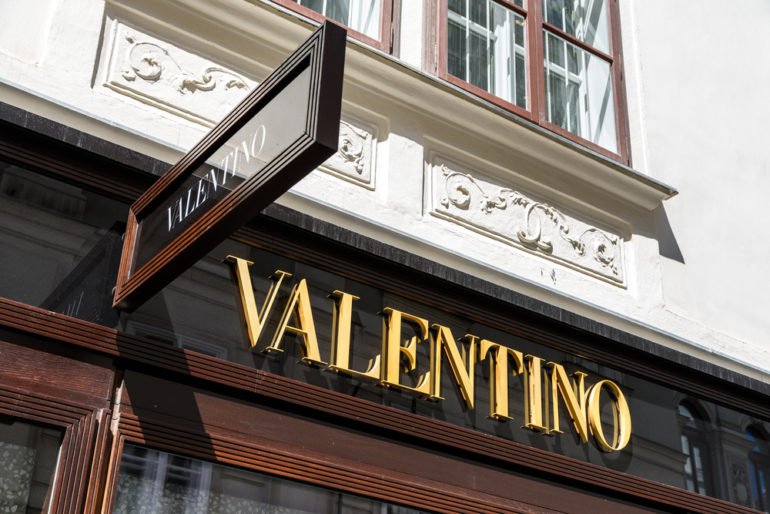In the world of high-end fashion, where trends come and go, one brand has managed to stand the test of time and retain its position as an epitome of sophistication and style – Valentino. Valentino is one of the most iconic and recognizable fashion brands in the world. Founded in 1960 by Italian designer Valentino Garavani, the brand has become synonymous with luxury, glamour, and romance. In this article, we will delve deeper into the world of Valentino, exploring its iconic designs, notable collaborations, and marketing strategies and marketing mix as a symbol of timeless luxury and Italian elegance. Prepare to be captivated by the allure of Valentino as we embark on a journey through the brand’s remarkable history and the indelible mark it has left on the fashion industry.
Valentino’s designs are characterized by their elegant simplicity and sophisticated use of color. The brand’s signature “Valentino red” is a deep, vibrant shade that has become a symbol of the brand itself.
Valentino’s collections include ready-to-wear, couture, accessories, and fragrances. The brand’s ready-to-wear lines are known for their feminine silhouettes and luxurious fabrics. Valentino’s couture collections are some of the most highly anticipated events in the fashion world. These elaborate gowns are often worn by celebrities and royals on red carpets and other special occasions.
Valentino’s accessories are also highly sought-after. The brand’s handbags, shoes, and jewelry are made from the finest materials and feature the brand’s signature attention to detail.
Valentino’s fragrances are also popular. The brand’s first fragrance, Valentino, was launched in 1978. Since then, Valentino has launched a number of other successful fragrances, including Valentino Donna, Valentino Uomo, and Valentino Voce Viva.
Valentino is a global brand with a presence in over 100 countries. The brand’s flagship store is located in Rome, Italy. Valentino also has stores in major cities around the world, including New York, London, Paris, and Tokyo.
Valentino is a beloved brand by celebrities and fashion enthusiasts alike. The brand’s designs have been worn by some of the most iconic women in the world, including Audrey Hepburn, Elizabeth Taylor, and Princess Diana.
Valentino is a timeless brand that continues to be relevant today. The brand’s designs are elegant, sophisticated, and luxurious. Valentino is a brand that represents the best of Italian fashion.
History of Valentino
The history of the Valentino brand is a tale of passion, talent, and unwavering dedication to the art of haute couture. Founded in 1960 by the visionary fashion designer Valentino Garavani, the brand quickly rose to prominence, becoming synonymous with luxury, elegance, and a distinct Italian flair. With its impeccable craftsmanship, innovative designs, and commitment to beauty, Valentino has left an indelible mark on the fashion industry and continues to inspire generations of designers and fashion enthusiasts worldwide.
Valentino Garavani, born in 1932 in Lombardy, Italy, showed a deep passion for fashion from an early age. After studying at the prestigious École des Beaux-Arts and the Chambre Syndicale de la Couture Parisienne in Paris, Garavani returned to Italy to fulfill his dream of establishing his own fashion house. In 1960, Valentino opened his first atelier on Via Condotti in Rome, marking the birth of the iconic Valentino brand.
One of the defining characteristics of the Valentino brand is the vibrant red hue that has become its signature. Known as “Valentino red,” this intense and seductive color became synonymous with the brand’s identity. Garavani introduced the striking shade in his collections, capturing the attention of the fashion world and creating an enduring symbol of sensuality and power.
Valentino’s creations quickly caught the eye of Hollywood celebrities and royalty, solidifying the brand’s reputation as a go-to choice for glamorous and sophisticated attire. Icons such as Elizabeth Taylor, Jacqueline Kennedy Onassis, Audrey Hepburn, and Sophia Loren were among the brand’s devoted clientele, cementing Valentino’s position as a leading luxury brand on the international stage.
Valentino Garavani’s design aesthetic was characterized by his unwavering attention to detail and his mastery of form and silhouette. He excelled in creating impeccably tailored garments that exuded elegance, femininity, and timeless beauty. Garavani’s designs often featured luxurious fabrics, intricate lacework, hand-embroidered details, and voluminous couture gowns that celebrated the female form.
Valentino’s success led to the expansion of the brand beyond haute couture. In the 1970s, the company launched ready-to-wear collections, bringing Valentino’s refined aesthetic to a broader audience. The brand also ventured into accessories, fragrances, and menswear, further solidifying its presence in the global luxury market.
In 2008, after nearly five decades at the helm of his eponymous brand, Valentino Garavani announced his retirement. The brand underwent a significant transition, and the reins were handed over to creative directors Maria Grazia Chiuri and Pierpaolo Piccioli. The duo successfully infused their fresh perspectives while respecting the brand’s heritage, ensuring its continued relevance and evolution.
Under the creative direction of Pierpaolo Piccioli, Valentino has experienced a renaissance, garnering critical acclaim and captivating a new generation of fashion enthusiasts. Piccioli’s visionary approach blends romanticism, innovation, and a celebration of diversity, resulting in collections that balance classic elegance with contemporary aesthetics. His designs often feature bold colors, unexpected juxtapositions, and a focus on individuality, earning the brand a reputation for pushing boundaries and challenging conventional norms.
Marketing Strategies of Valentino
Valentino has captivated the hearts of fashion enthusiasts for decades. To maintain its competitive edge in the market, Valentino has implemented a range of effective marketing strategies. In this article, we will explore eight key strategies that have contributed to the brand’s success.
Influencer Marketing: Valentino leverages the power of influencer marketing to enhance brand visibility and connect with target audiences. Collaborating with fashion influencers, celebrities, and style icons allows Valentino to showcase its products to a broader audience and generate buzz around new collections. By carefully selecting influencers whose personal brand aligns with Valentino’s aesthetic, the brand effectively reaches and engages with potential customers.
Experiential Marketing: Valentino creates immersive and memorable experiences through experiential marketing initiatives. The brand organizes exclusive events, runway shows, and pop-up stores to provide customers with an up-close and personal encounter with its products. By allowing individuals to engage with the brand in a unique and interactive way, Valentino creates a lasting impression and fosters brand loyalty.
https://www.youtube.com/watch?v=-d_aszKp_T4
Emotional Branding: Valentino establishes an emotional connection with its audience by leveraging storytelling and brand narratives. Through compelling campaigns and creative content, the brand showcases its heritage, craftsmanship, and dedication to luxury. By appealing to customers’ emotions, Valentino establishes itself as a symbol of elegance, sophistication, and aspiration.
Digital Presence: Valentino maintains a strong digital presence across various platforms to reach a wider audience and engage with customers on a global scale. The brand utilizes social media channels, including Instagram, Facebook, and YouTube, to share behind-the-scenes content, fashion inspiration, and product updates. Valentino’s website serves as an e-commerce platform, offering a seamless shopping experience and showcasing its latest collections.
Collaborations: Valentino strategically collaborates with other influential brands, artists, and designers to create limited-edition collections. These partnerships generate excitement among existing customers and attract new ones who are drawn to the unique combination of Valentino’s aesthetic and the collaborators’ distinct styles. Collaborations also help Valentino tap into new markets and strengthen brand positioning.
Personalization: Valentino recognizes the importance of personalization in delivering a tailored customer experience. The brand utilizes customer data to offer personalized recommendations, targeted promotions, and exclusive offers. By understanding individual preferences and behaviors, Valentino creates a sense of exclusivity and ensures customers feel valued and understood.
Sustainable Practices: Valentino embraces sustainability as a key component of its marketing strategy. The brand emphasizes its commitment to responsible fashion by incorporating eco-friendly materials, supporting ethical production processes, and engaging in social initiatives. By aligning with environmentally conscious consumers, Valentino cultivates a positive brand image and differentiates itself in the market.
Story-driven Content Marketing: Valentino utilizes content marketing to tell engaging stories that resonate with its audience. Through blog posts, videos, and editorial features, the brand shares in-depth insights into its design process, craftsmanship, and inspirations. By providing valuable and educational content, Valentino establishes itself as an authority in the fashion industry, building trust and credibility with its customers.
Valentino’s success can be attributed to a combination of influencer marketing, experiential marketing, emotional branding, a strong digital presence, collaborations, personalization, sustainability, and story-driven content marketing. By implementing these strategies, Valentino continues to captivate fashion enthusiasts worldwide, solidifying its position as a leading luxury brand.
Marketing Mix of Valentino
Valentino has mastered the art of creating exquisite designs and captivating the hearts of fashion enthusiasts worldwide. Behind its success lies a well-crafted marketing mix, comprising the four essential elements: product, price, place, and promotion. In this article, we will delve into the details of Valentino’s marketing mix, exploring how the brand strategically combines these elements to create a recipe for success.
Product: Valentino offers a wide range of products that exude elegance, sophistication, and impeccable craftsmanship. From ready-to-wear clothing to accessories, footwear, and fragrances, each item reflects the brand’s commitment to luxury and timeless design. Valentino carefully curates its product portfolio, ensuring it aligns with the desires and aspirations of its target market. The brand constantly innovates and introduces new collections, staying ahead of fashion trends while staying true to its distinctive aesthetic.
Price: Valentino positions itself as a high-end luxury brand, commanding premium pricing for its products. The brand’s pricing strategy reflects the exclusivity, craftsmanship, and brand equity associated with its name. While targeting affluent customers, Valentino ensures that the quality, attention to detail, and the overall luxury experience justifies the higher price point. The pricing strategy also helps to maintain a sense of exclusivity, appealing to consumers seeking status and prestige.
Place: Valentino carefully selects its distribution channels to ensure its products are available in prestigious and upscale locations worldwide. The brand operates its own flagship stores in major fashion capitals such as Milan, Paris, London, and New York, allowing customers to immerse themselves in the Valentino world. Additionally, Valentino partners with select high-end department stores and luxury boutiques to expand its reach and access new markets. The strategic placement of its stores ensures that Valentino remains accessible to its target audience while maintaining an aura of luxury.
Promotion: Valentino’s promotion strategy revolves around creating a strong brand image and generating desire among consumers. The brand invests heavily in advertising campaigns across various media channels, including print, digital, and social media. These campaigns feature high-profile models, celebrities, and influencers who embody Valentino’s aesthetic and appeal to its target market. The brand also participates in prestigious fashion events, runway shows, and collaborations to generate buzz and maintain its relevance in the fashion industry. By leveraging storytelling, compelling visuals, and emotional connections, Valentino’s promotional efforts create a sense of aspiration and exclusivity.
Valentino’s success can be attributed to its meticulous management of the marketing mix. The brand’s exquisite products, premium pricing, strategic placement of stores, and impactful promotion strategies work in harmony to create a desirable and iconic brand. Valentino’s commitment to luxury, elegance, and craftsmanship shines through each element of the marketing mix, allowing the brand to maintain its position as a leader in the luxury fashion industry. By continuously refining and adapting its marketing mix, Valentino ensures that it remains at the forefront of fashion and continues to capture the hearts of fashion enthusiasts worldwide.
Also Read: Marketing Strategies, Marketing Mix and STP of Sisley Paris
To read more content like this, subscribe to our newsletter



